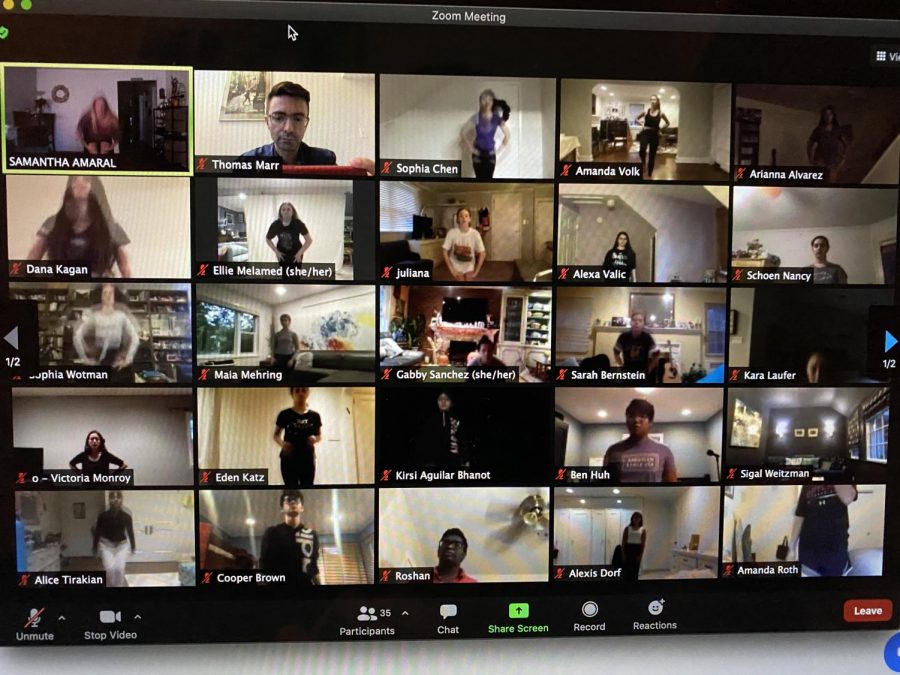Acting through a Screen
The Production of a Virtual Musical
Rehearse the screen—The cast of the virtual, The Chorus Line, holds their after school meeting virtually through zoom during the pandemic.
March 31, 2021
The week before Thanksgiving is usually a busy time for the annual musical. Songs from the musical flood the Friday music playlist. Shirts promoting the musical are worn by all cast and crew members. Yet this year, there was a noticeable absence. Due to the ongoing pandemic, every production aspect of this year’s musical, A Chorus Line, was done virtually; the show will be available for live-streaming in late April of 2021. While putting together the musical has taken longer than in previous years, it will bring about a new, memorable experience.
A Chorus Line tells the story of dancers auditioning for roles in a Broadway production directed by a man named Zach. The musical centers around the auditions as well as the performers and their individual stories. “One of the many reasons I chose A Chorus Line is because it would not overwhelm the students too much by giving them too many factors that they need to take into consideration,” said Mr. Thomas Marr, director of the musical. “Many of the scenes focus on the individual performers reacting to Zach, who would be behind the screen and in the audience, and it keeps things nice and simple.”
The production of A Chorus Line started off with casting. Students interested in participating in the musical were given the dialogues, monologues, and music sheets to use to film their auditions. After all the auditions were submitted, call backs began, and selected students were invited to sing and read once more before final casting was determined.
Once the casting was completed, rehearsals began. Rehearsals took place after school through Zoom, and they were often recorded so the students had access to them later on. “Zoom rehearsal is more challenging than in-person rehearsal because there are more things that have to be considered,” said Rosanna Gao, who plays Maggie in The Chorus Line. “Vocal rehearsals, for example, can be extremely difficult because Zoom has voice lagging. I could be singing a note and someone else can be singing that same note, but Zoom makes it so that I hear that person two seconds after. So what we would have to do is to have one person sing, while the others mute themselves.”
When rehearsals were completed, the recording processes began. The performers were supplied with microphones that were attached to the iPads for better sound quality and a ring light to improve the lighting quality. While recording a song, the students listened to a guided vocal track played in their ear and they sang over the recording. While recording dialogue, they listened to the scenes recorded in rehearsal and they spoke over their lines. These steps help ensure that everything syncs up when all the video clips come together.
Filming presents even more challenges. Numerous factors must be considered, such as lighting quality or finding a quiet place in the house. “The biggest challenge is filming yourself while acting alone,” said cast member Sarah Bernstein. “The common thing people say is that acting is reacting. A lot of things you do in theater would involve other people on stage, and it’s hard to go off of a pre-made recording when you can’t bounce off of each other.”
After the students finished filming, the individual clips needed to be placed together. Performers submitted their recordings to be reviewed by Mr. Marr and Ms. Debra Dumas, who then selected the two recordings from each student and sent them to Mr. Robert Zahn, the editor of the virtual musical. Mr. Zahn then organized all the files into the appropriate folders based on sections and songs. Once Mr. Zahn sorted all the files, he started putting it all together with his team.
One of the first steps to editing the virtual musical was incorporating the music. Although the performers sang along with the soundtrack, they wore earbuds so the soundtrack was excluded. Mr. Zahn then needed to take the videos and piece them together with a professionally recorded performance track so everything can perfectly sync up.
The rest of the editing process are planned out once all the footage has been imported and organized. “We plan on being creative and flexible with the editing,” said Mr. Zahn. “After we sync the music with the vocal performances, we are able to play around with editing and see how we can work with whatever materials that have been given.”
Producing a virtual musical has and will continue to require significant effort. Nevertheless, this strange and unfamiliar project was a new and exciting experience. “Every student who is involved in the musical should feel that they gained an experiential reward,” said Ms. Dumas. “I hope that once this project is complete and the students see the final product, they will be proud that they were able to be part of something so spectacular.”






